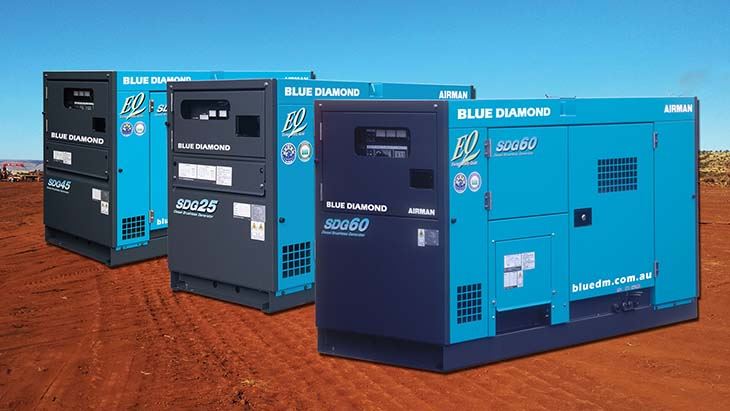What is a 3 Phase Generator and How Does it Work?
22nd Jan 2021
Generators deliver single phase or 3 phase power. Single and 3 phase generators suit different applications and situations.
Let's look at single vs 3 phase generators and the applications for each.
How single phase power works
Single phase uses a single conductor active wire to carry the electrical current and a neutral wire to return it, thus completing a circuit. It can supply up to 240 volts of power.
In single phase power delivery happens in a single wave format, which peaks and then drops again to zero before rising again. This process is generally not detectible as it all happens so quickly.
Since single phase relies on a single wire it means if the power does fail, it does so completely.
What is 3 phase power?
3 phase power on the other hand uses three active wires, 120 degrees apart, and one neutral wire. It can deliver up to 415 volts.
In a 3 phase system, the three active wires each feed into the neutral wire in turn. So power is delivered in three separate waves in sequence, but with some degree of overlap. This means the delivery of power never completely falls to zero.
Supply is also more reliable and efficient as the wires can compensate for each other in a failure situation. So if one wire fails, the other two can continue supplying power to some extent.
Single vs 3 phase generators

While 3 phase offers greater efficiency, it doesn’t necessarily mean you should buy a 3 phase generator. 3 phase models are more expensive to both buy and maintain, and are mostly only required for commercial, industrial or off-grid situations.
If all you need from a generator is to power regular domestic appliances, a single phase unit should be adequate.
Here are some single phase and 3 phase generator situations.
Where is single phase power used?

Single phase is used for residential grid electricity supply to most regular homes and small businesses. This indicates the overall efficiency of single phase power for domestic situations.
Small and portable generators are also mostly single phase. Here are some situations where you might use one:
- Recreational – such as camping or caravanning, boating and fishing, to power appliances such as a fridge and television. Inverter models are best for this, as they are quiet, reliable and suitable for powering sensitive devices such as mobile phones due to minimal distortion.
- Household backup – inverters and other portable generators can be used for small backup power in outages, or for some off-grid situations, like charging a solar battery. Another option is a fixed home and backup single phase unit, such as from the Generac range.
- Trade sites – portable generators can be used on some construction sites or other types of worksites or farms to power equipment.
What is 3 phase power used for?

3 phase grid power is used in many larger businesses and homes where a greater delivery of power is needed.
3 phase generators suit situations that have high power needs or that require a very reliable and continuous supply. Here are some examples:
- Household backup – for example, some home backup fixed generator models are 3 phase to suit homes or businesses with a power requirement above the standard 240v.
- Job sites – a 3 phase model can be utilised on sites requiring substantial power supply, such as in commercial construction.
- Industrial Use – stationary diesel models are often deployed on heavy industry such as mining or on agricultural sites.
- Off-grid properties – a property with limited or no grid access but with substantial power needs may benefit from one of the stationary 3 phase models.
- Commercial buildings – e.g. for larger-scale power backup such as in data centres, shopping centres, large office buildings, and residential towers.
3 phase generators generally come equipped with an automatic transfer switch (ATS) that senses a loss of power and kicks the machine into operation in response.
Benefits of 3 phase generators

3 phase generators are an ideal solution for sites and properties requiring reliable backup or primary power.
For example, a 24-hour data centre or factory that can’t afford to lose continuous power would benefit from installing a large 3 phase generator for backup in case of loss of grid supply. Some remote mining sites also install 3 phase portable or stationary mine spec generators for primary or backup power.
A 3 phase generator can be used to power the following:
- Large factory equipment setups.
- High-load households and small businesses to distribute the power load.
- Certain types of tools and equipment such as electric kilns, lathes and screen printing machines.
- Large size ducted air conditioning systems.
- Mining equipment such as large drills, blasting tools and crushers.
In fact, any situation where reliable 3 phase power is required to keep operating.
What do 3 phase generators cost?
Not all 3 phase generators fall into the same category, and prices vary according to type, features and power output capacity in kVA. Here is a rough guide.
- Portable 3 phase – range from around $2,000 (6kVa) to $8,000 (10 kVA).
- Fixed 3 phase home generators – such as the Generac 20 kVA at $9,000 to $10,000.
- Ultra-silenced large diesel models – from approximately $26,000 (25kVA) to $140,000 (300kVA).
- Standby diesel generators – priced from $6,000 (10kVA) to $37,000 (220kVA).
- Mine spec diesel generators – start at around $4,000 (6kVA) through to $40,000 (45kVA).
- Large stationary diesel generators – can cost anything from $11,000 (6kVA) to $450,000 (1,100 kVA).
Where can I buy a 3 phase generator?
You can buy 3 phase generators from various suppliers, but it’s important to look for a reliable one with service agents that offers ongoing support and extended warranties.
When seeking out the best 3 phase model for your situation you first need to get a rough idea of the size of machine you need in kVA. Feel free to contact us if you need assistance with this, and to get professional advice on selecting the best 3 phase generator for your requirements.



